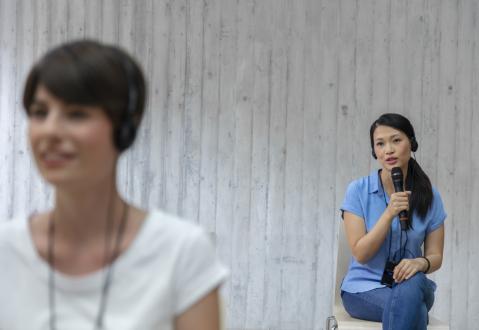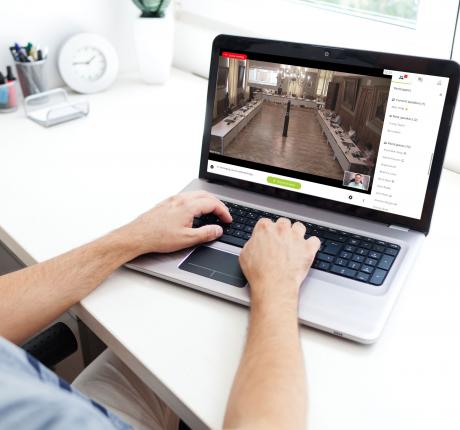
Whispered Interpretation - Monika Stahuber-Tóth
Interview with interpreter Monika Stahuber-Tóth about using Unite as a portable whisper interpreting system
Televic: Can you quickly describe your work as a whisper interpreter?
Monika Stahuber-Tóth: I am a publicly appointed and sworn interpreter specialising in interpreting in the justice sector, meaning I often work for courts, public prosecutors and lawyers. This often involves chuchotage, also known as whisper interpreting: I whisper what has been said to a particular individual.
Televic: You often work in courtrooms and at events. How has the current COVID-19 situation changed how you work as an interpreter?
Monika Stahuber-Tóth: Because of the social distancing rules, the distance I stand from the person for whom I am interpreting (the defendant, co-claimant, respondent, claimant, witness, etc.) has increased from 40cm to at least 2m, which is not a good situation for whisper interpreting: if I whisper what has been said to the defendant from a 2–3m distance, they will no longer be able to hear me. This is made even more difficult because the courts employ simultaneous interpreting to ensure proceedings aren’t unnecessarily prolonged. That means I’m speaking at the same time as the person whose words I am interpreting, e.g. the judge. Depending on the size of the court room, they may be sitting 4–9m away from me. If as a result of the distance between us I have to interpret loudly for the defendant so they can hear me from two metres away, I will no longer be able to hear the judge because of the volume of my own voice, making simultaneous interpreting simply impossible.
Televic: Why did you buy a whisper interpreting system? Had you already been using technology before?
Monika Stahuber-Tóth: That’s why I needed to look for a good solution. Unfortunately most courtrooms aren’t technologically up to date. They don’t normally have whisper interpreting systems. And in the few cases where they do have them, they are very basic models that are unsuitable for efficient, comfortable interpreting. They simply don’t have the sound quality, battery performance and the functions (mute, single-ear headset, etc.) that I need to work professionally. The basic models also produce an unpleasant static noise or buzzing that leads to headaches after several hours of interpreting...
Televic: How did you come across the idea of using Televic's Unite as a solution for whisper interpreting?
Monika Stahuber-Tóth: I was desperately looking for a good, affordable interpreting system that I could put together myself and expand if needed. I tried several devices, but they were either not good enough from a quality or handling point of view or else were much too expensive. I was at the end of my tether and was telling my husband about it over dinner, and suddenly that’s where the name Televic came up. We then did some research on the Televic website, found something suitable and ordered a test device.
Televic: You tested the system in advance – what impressed you during the test?
Monika Stahuber-Tóth: The very high sound quality, useful sound settings (I’m really impressed that I can suppress ambient noise such as paper rustling or the opposing party smacking their lips), the headset (available as a single-ear model so that I can hear the external world, such as the judge, with one ear), and the correctly positioned microphone. The mute function and the fact you can add new receiver units as required are fantastic. I didn’t have to buy a case with 5–6 receiver units, which I hardly ever need. Rather, I was able to start with just one transmitter unit and one receiver unit and then I can add to them later, at a time that suits me. And that means the price/performance ratio is right too.
Televic: How do you use the Unite system?
Monika Stahuber-Tóth: I hang the transmitter unit around my neck using the included cord and put the headset on. I set up the client (e.g. the defendant) with the receiver unit and their own headset. I sit approx. 2–3m from the client in order to maintain coronavirus social distancing. I whisper what is being said into my headset microphone while simultaneously listening to the speaker (e.g. the judge). Despite the large distance between us, the defendant is able to hear me very well, even if they are sitting very far away from me, because the system means that my own volume is no longer disruptive while listening during whisper interpreting. And the system works the other way round too. If it is the defendant’s turn to speak, because they want to make a statement to the court, they can also speak into their headphones’ microphone and I will hear them very well despite the distance between us. While I am listening I can also interpret out loud so that everyone in the courtroom can hear what they are saying. My own volume doesn’t stop me from hearing the defendant because I can hear them through the headphones in very good quality. And they won’t suffer hearing damage while I interpret what they have said for the listeners in the courtroom, because I can mute myself for the defendant. And if I forget, they can mute me too.
With the help of the system, simultaneous interpreting and whisper interpreting are just as possible now as before coronavirus, despite social distancing. We often don’t wear face masks in courtrooms so that we can see and understand each other, which is particularly important during court proceedings in which people are speaking the whole time. This makes it even more important that we maintain social distancing while ensuring that we are not prevented from working, holding proceedings or speaking and that we do not risk our own health.
Televic: Thank you.
Used equipment unite whispered interpreting system
- 1 x Unite TP bodypack transmitter
- 1 x Unite RP-T bodypack receiver
- 2 x HSP 321 headset
- 2 x charging cable USB-A / USB-C
Interpreting with Unite
The wireless, tap-proof Unite system is extremely flexible and can be expanded as desired. This means that with extra receivers more people can receive the foreign language, or two interpreters can sub in for each other with an extra transmitter. Unite is also ideal for transmitting foreign languages to participants in larger events that include an interpreting booth – with significantly lower installation costs than infrared systems.
Tip: These components can also provide assistive listening for the hard of hearing, which is now a requirement for public events and institutions. With the induction neckloop, the sound is transmitted directly to the user’s hearing aid or cochlear implant.




